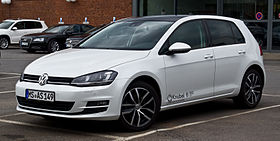
Back Volkswagen Golf VII Danish VW Golf VII German Volkswagen Golf VII Spanish فولکسواگن گلف امکی۷ Persian Volkswagen Golf VII Finnish Volkswagen Golf VII French VW Golf VII FRR Volkswagen Golf Mk7 ID Volkswagen Golf VII Italian フォルクスワーゲン・ゴルフVII Japanese
| Volkswagen Golf Mk7 | |
|---|---|
 | |
| Overview | |
| Manufacturer | Volkswagen |
| Production | 2012–2020 (Europe) 2013–2020 (China) 2015–2020 (Brazil) 2014–2021 (Mexico) |
| Model years | 2015–2021 (North America) |
| Assembly |
|
| Designer |
|
| Body and chassis | |
| Class | Compact car/small family car (C) |
| Body style | |
| Layout | Front-engine, front-wheel-drive Front-engine, all-wheel-drive |
| Platform | Volkswagen Group MQB |
| Related | Volkswagen Golf Sportsvan Audi A3 Mk3 Audi TT Mk3 SEAT León Mk3 Škoda Octavia Mk3 |
| Powertrain | |
| Engine | |
| Electric motor | AC electric motor 136 PS (100 kW; 134 bhp) (e-Golf) |
| Transmission | |
| Battery | 35,8 kWh (e-Golf), 8,7kWh (GTE) |
| Dimensions | |
| Wheelbase | 2,631–2,637 mm (103.6–103.8 in) 2,619–2,629 mm (103.1–103.5 in) (facelift) |
| Length |
|
| Width | 1,791–1,799 mm (70.5–70.8 in) |
| Height | 1,435–1,514 mm (56.5–59.6 in) |
| Kerb weight | 1,205–1,500 kg (2,657–3,307 lb)[3][4] |
| Chronology | |
| Predecessor | Volkswagen Golf Mk6 |
| Successor | Volkswagen Golf Mk8 Volkswagen ID.3 (for e-Golf) |
The Volkswagen Golf (Mk7) is a C-segment car manufactured by German automobile manufacturer Volkswagen. It is the seventh generation in the Golf series and the successor to the Golf Mk6, and was introduced in Berlin on 4 September 2012, before a public launch at the 2012 Paris Motor Show.[5] Sales in Europe began with the model in November 2012.[6]
Marketed in three-door and five-door hatchback, van, and estate forms, the Golf Mk7 shares the MQB platform with the third generation Audi A3, SEAT León and Škoda Octavia.
In November 2016, Volkswagen presented a facelift of the Golf Mk7.[7] It was replaced in December 2019 by the Golf Mk8, which is built on the MQB Evo platform.[8] Production of the e-Golf and the Golf Variant ended in mid-2020.[9][10]
- ^ Wicaksono, Krisna (20 June 2016). "VW Indonesia Setop Produksi Golf TSI" [VW Indonesia ended Golf TSI production]. www.viva.co.id (in Indonesian). Retrieved 17 June 2022.
- ^ US D690231, Bischoff, Klaus; Lichte, Marc & Mindt, Andreas J. et al., "Motor vehicle", published 2013-09-24, assigned to Volkswagen AG
- ^ "Golf-vii engines & performance". Volkswagen UK. Retrieved 14 July 2015.
- ^ "Golf-gti-vii engines & performance". Volkswagen UK. Retrieved 14 July 2015.
- ^ Kable, Greg (4 September 2012). "2013 Volkswagen Golf revealed". Autocar. Retrieved 4 September 2012.
- ^ Auto, Motor und Sport (7 November 2012). "VW Golf VII: Markteinführung am Samstag" [VW Golf VII: Market introduction during saturday]. Auto-Motor-und-Sport.de (in German). Archived from the original on 15 July 2015. Retrieved 14 July 2015.
- ^ GmbH, Frankfurter Allgemeine Zeitung (10 November 2016). "Weltpremiere in Wolfsburg: VW hat den Golf renoviert". FAZ.NET.
- ^ Gilboy, James (3 October 2019). "2020 Volkswagen Golf MK8 Set for October 24 Debut in Wolfsburg: Report". The Drive.
- ^ "VW Gläserne Manufaktur - 16.155 e-Golf: Gläserne Manufaktur 2019 mit Allzeit-Produktionsrekord". VW Gläserne Manufaktur (in German). Retrieved 22 January 2020.
- ^ "Produktion des ID.3 im Werk Zwickau startet im November". Volkswagen Newsroom (in German). Retrieved 22 January 2020.